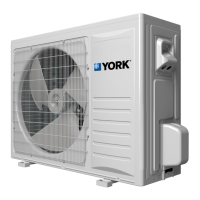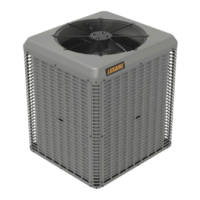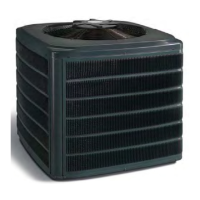6. Protect the vapor valve with a wet rag and braze
the vapor line connection to the outdoor unit.
The nitrogen flow should be exiting the system
from the vapor service port connection. After this
connection has cooled, remove the nitrogen source
from the liquid fitting service port.
7. Replace the Schrader core in the liquid and vapor
valves.
8. Leak test all refrigerant piping connections
including the service port flare caps to ensure they
are leak tight. Do not overtighten (between 40 in.·lb
and 60 in.·lb maximum).
NOTICE
Pressurize the lineset and the indoor coil to 250 psig
with dry nitrogen and leak test with a bubble type leak
detector. Then release the nitrogen charge. Do not
use the system refrigerant in the outdoor unit to purge
or leak test.
9. Evacuate the vapor line, indoor coil, and liquid line
to 500 microns or less.
NOTICE
If a leak is suspected, leak test with dry nitrogen to
locate the leak. Repair the leak and test again. To
verify that the system has no leaks, close the valve
to the vacuum pump suction to isolate the pump and
hold the system under vacuum. Watch the micron
gauge for a few minutes. If the micron gauge indicates
a steady and continuous rise, it is an indication of a
leak. If the gauge shows a rise, then levels off after
a few minutes and remains fairly constant, it is an
indication that the system is leak free but still contains
moisture and may require further evacuation if the
reading is above 500 microns.
10. Release the refrigerant charge into the system.
Open the liquid line service valve by removing the
plunger cap and back out the valve stem counter-
clockwise using a hex head wrench until fully open.
Then, open the vapor line service valve in the same
way. If the service valve is a ball type valve, use an
adjustable end wrench to turn the valve 1/4 turn to
open.
11. Replace the caps on the service ports. Do not
remove the flare caps from the service ports except
when necessary for servicing the system.
12. Replace the plunger caps finger tight, then tighten
an additional 1/12 turn (1/2 hex flat). Ensure to
replace the caps to prevent leaks.
CAUTION
Do not connect manifold gauges unless required to
mitigate an identified issue. Approximately 3/4 oz
of refrigerant is lost each time a standard manifold
gauge is connected.
WARNING
Never attempt to repair any brazed connections while
the system is under pressure. Personal injury could
result.
Refrigerant charging
CAUTION
Refrigerant charging must only be carried out by a
licensed qualified air conditioning contractor.
CAUTION
Compressor damage occurs if the system is
incorrectly charged. On new system installations,
charge the system as instructed in the Tabular Data
Sheet for the matched coil and follow the guidelines in
this instruction.
CAUTION
Do not leave the system open to the atmosphere. Unit
damage could occur due to moisture being absorbed
by the POE oil in the system. This type of oil is highly
susceptible to moisture absorption.
CAUTION
It is unlawful to knowingly vent, release, or discharge
refrigerant into the open air during repair, service,
maintenance, or the final disposal of this unit.
Installation Manual: HMH7 Series - 17 SEER Horizontal Discharge Modulating Heat Pump12
Johnson Controls Ducted Systems

